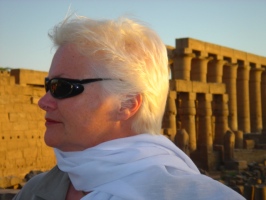Parisians had a few pumpkins, skeletons, and witches in shop windows the last few weeks, but I wouldn’t say they celebrate Halloween. But November 1, All Souls’ Day or Day of the Dead, is a major holiday. Today’s November 1 and it wasn’t raining, so it was a good day to visit Cimetiere du Pere Lachaise, Father Lachaise’s Cemetery, in eastern Paris.
Pere Lachaise isn’t an American-type cemetery with tombstones sticking up out of large expanses of clipped lawns. It’s more like a granite city built on a hill And, at 118 acres, it’s the biggest cemetery–and green space–in Paris. The cemetery is named after Jesuit priest Pere Francois de la Chaise, the confessor to Louis XIV. Today the cemetery was crowded with families and tourists. And lots and lots of chrysanthemums.
Â
Pots of mums decorated family graves. Chrysanthemums were bunched along stair steps. Baskets of mums were massed on the monuments to victims of Nazi concentration camps and forced labor factories. People were carrying pots of mums in great plastic bags, heading to an afternoon of caring for family crypts. Women were cleaning grave tops and sweeping off dead leaves. November 1 was a sober, beautiful day to visit this famous resting place for the dead.
The cemetery contains about 70,000 graves, including writers like Molière, Balzac, and Oscar Wilde; singers Edith Piaf and Maria Callas; composer Frédéric Chopin; and painters Pissarro, Gericault, and Delacroix. And Doors frontman Jim Morrison. His modest gravesite is shown below.

Morrison died in Paris on July 3, 1971. Friends submitted an application to have him buried at Pere Lachaise, saying “he was a writer.” His grave attracts great attetion from Americans, of course, but also from fans around the world. The grave is modest, but it attracted graffiti, pot smoking, and other behaviors that greatly concerned cemetery authorities. The tomb now requires a 24-hour guard. Today there was a female officer watching the hordes of visitors to Jim’s grave.
Jim’s grave had been unmarked until French officials placed a shield over it, which was subsequently stolen in 1973 by “Ian The Gecko”. In 1981, Croatian sculptor Mladen Mikulin put a bust of Jim on top of the gravestone, but it was stolen in 1988. A new headstone was erected with a Greek inscription reading ΚΑΤΑ ΤΟΠΔΑΙΜΟÎΑ ΕΑΥΤΟΥ (True to his own spirit). When my sons and I visited Jim’s grave in 2002, there were still small signs on nearby gravestones with “Jim” and an arrow scrawled in charcoal, pointing the way to this special spot.
The Mur des Fédérés (Communards’ Wall) is also located in this cemetery. Here 147 Communards, the last defenders of the workers’ district Belleville, were shot on May 28, 1871—the last day of La Semaine Sanglante (Bloody Week)–ending the Paris Commune, a Socialist-anarchist government that ruled Paris for several months in 1871. The Communards were shoved into a mass grave only the eastern fense of the cemetery, festooned today with hundreds of pots of mum. Since that 1871 execution, Père Lachaise gained a special emotive role for the political left. Many mum bouquets today were put on monuments to Communards and various resistance fighters, their ribbons identifying the flowers as being from the Communist Party.nted to get to know the
Cemeteries bring out the contemplative side of even the most jaded tourist, and this cool, overcast November 1 evoked stories of death and family members as my husband and I picked our way up and down the cobbled cemetery avenues. This isn’t a day trip away from historic Paris’s cafes and museums for everyone. But the beauty, art, strolling families, and masses of bright chrysanthemums were a wonderful, thoughtful day out for us.




 Â Â Â Â
    
3 Comments